Toasted anchovies and sesame seeds coated in a honey-soy sauce glaze, Tazukuri is a sweet and savory snack served in the Osechi Ryori menu of traditional Japanese New Year foods. You can also enjoy these candied anchovies with a cold beer anytime of the year!
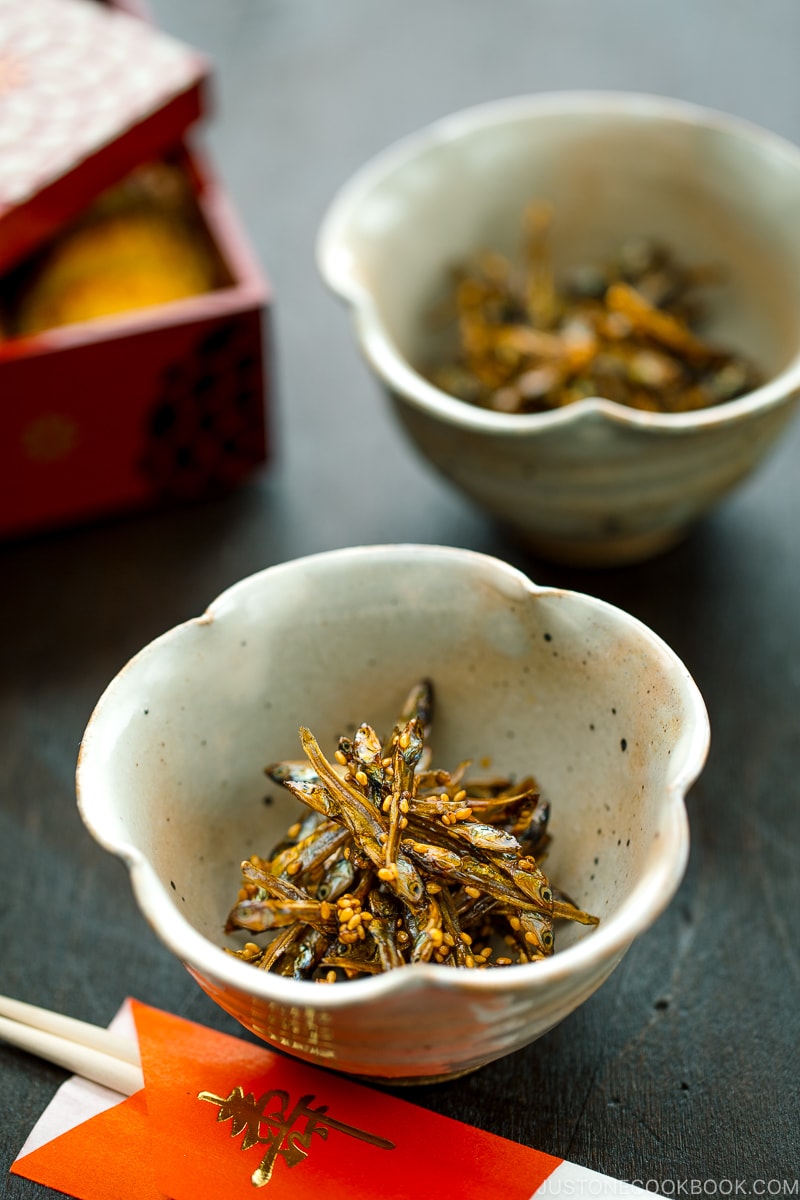
To kick off my Osechi Ryori Recipe Series (おせち料理), I’d like to start with a classic dish called Tazukuri (田作り) or candied anchovies. These anchovies are crunchy, sweet, and deeply savory, which make them a fantastic snack to enjoy along with the other delicacies served as part of the Japanese New Year’s foods.
If you love munching on little bites with cold beer or sake on New Year’s Day, you will love tazukuri! What more? They are ridiculously easy to make and ready in 10 minutes!
Tazukuri – Well-Meaning & Savory Bites for Osechi Ryori
Tazukuri (田作り) is a very popular dish for osechi ryori and it is made of roasted Japanese anchovies coated in a sweet soy sauce glaze. Cooked in low heat over a frying pan with sesame seeds, these anchovies are then tossed in sake, soy sauce, sugar, and honey until caramelized and crispy.
Japanese anchovies play an important role in Japanese cuisine. We eat tazukuri on New Year’s Day as they symbolize a bountiful harvest. Tazukuri (田作り) literally translates as “making (作り) rice paddy (田)” as anchovies were once used as fertilizers for rice fields.
Because Japanese anchovies are known as a great source of calcium, my mom always made sure I had eaten tazukuri on New Year as they are good for strong bones. Now it’s my turn to make sure my children eat this dish for strong bones.
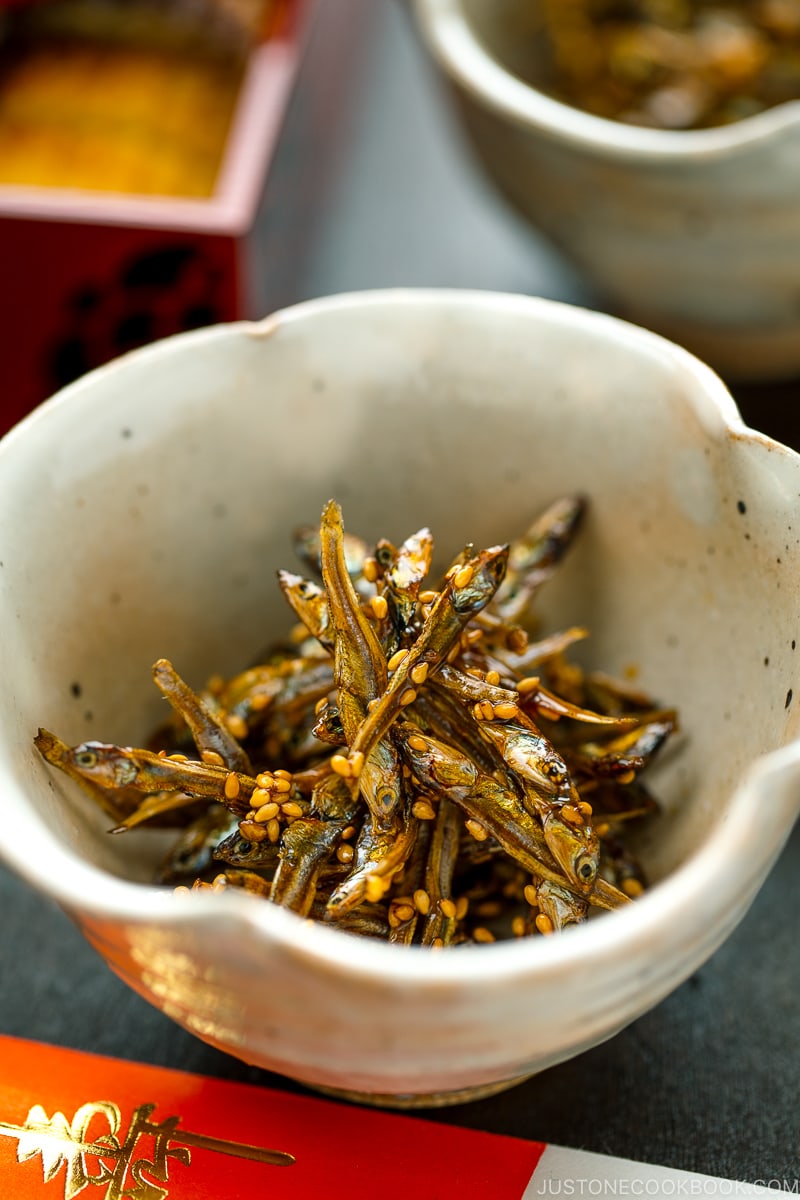
Ingredients You’ll Need
- Dried Japanese anchovies (Tazukuri or Iriko/Niboshi)
- Toasted white sesame seeds
- Seasonings: sake, soy sauce, sugar, and honey
I used only sesame seeds for my tazukuri, but you can also add silver almonds or crushed walnuts to the mix.
Different Types of Dried Anchovies
For this recipe, we use a specific type of dried Japanese anchovies called tazukuri—yes, the same name as the dish. Tazukuri is simply rinsed in water and dried, without boiling in salt water like regular anchovies. Therefore, the “tazukuri” anchovies are not salty compared to the regular ones. They are also flat and straight.
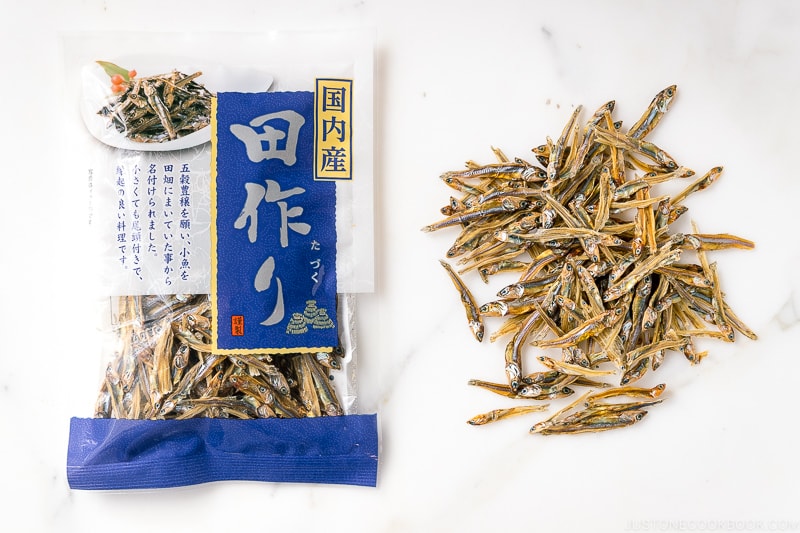
You can find tazukuri at Japanese grocery stores only in December, just around the time when people start preparing for the Japanese New Year celebration. Unfortunately, since this is a very specific ingredient that’s used for the Japanese New Year, you will most likely not find them in Asian grocery stores.
You can definitely use regular dried anchovies. They are called iriko (いりこ) in the Osaka region and niboshi (煮干) in the Tokyo region. Unlike tazukuri, they have been boiled in salt water and then dried, so iriko/niboshi are slightly saltier.
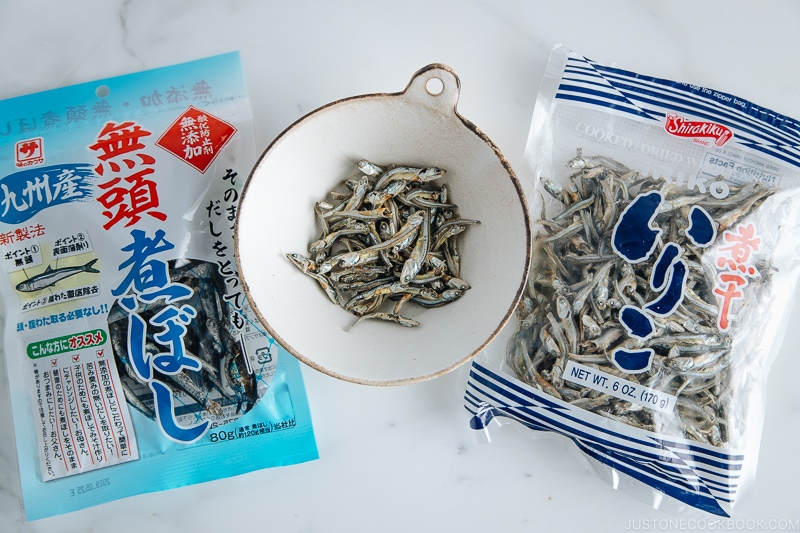
Iriko or niboshi are often used in making dashi soup stock or eaten whole as a snack. The bold, savory taste is unbeatable. They are also very popular in Korean and Southeast Asian cuisine.
👉🏻 You can read more about iriko/niboshi on my pantry page.
Where to buy dried anchovies: You can find iriko/niboshi sold in plastic bags in most Japanese and Asian grocery stores. Both the Japanese and Korean baby anchovies are interchangeable.
Make Ahead Recipes for Osechi Ryori
There are a variety of dishes that go into making the New Year’s feast, so I like to make a list for the ones that I can make ahead. Tazukuri is often one of the first items I prepare early since they store well in the refrigerator for 7-10 days.
For those of you who would like to adopt Japanese New Year traditions, I definitely recommend making these candied anchovies for your osechi ryori!
More traditional osechi dishes you can easily make ahead:
- Instant Pot Kuromame (Sweet Black Soybeans)
- Kuri Kinton (Candied Chestnuts and Sweet Potatoes)
- Datemaki (Sweet Omelet with Fish Cake)
- Kobu Maki (Salmon Kombu Roll)
❤️ Learn more about Japanese New Year’s traditions and browse our complete osechi ryori menu.
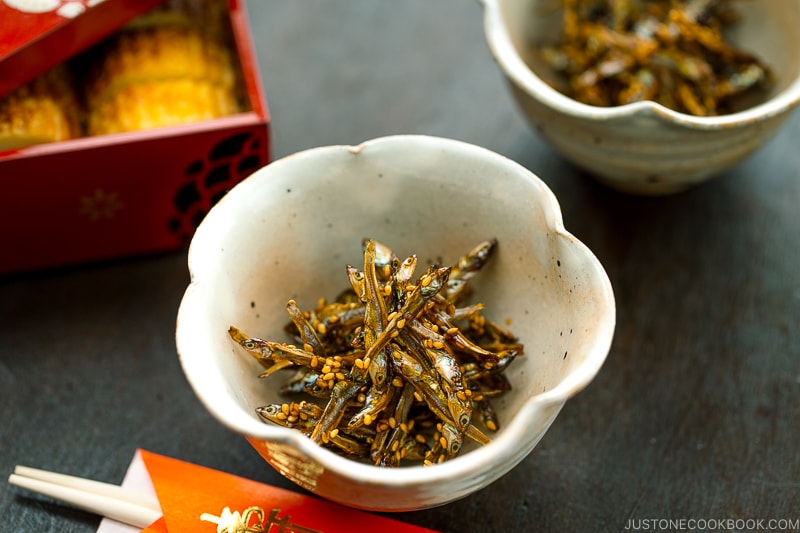
Wish to learn more about Japanese cooking? Sign up for our free newsletter to receive cooking tips & recipe updates! And stay in touch with me on Facebook, Pinterest, YouTube, and Instagram.
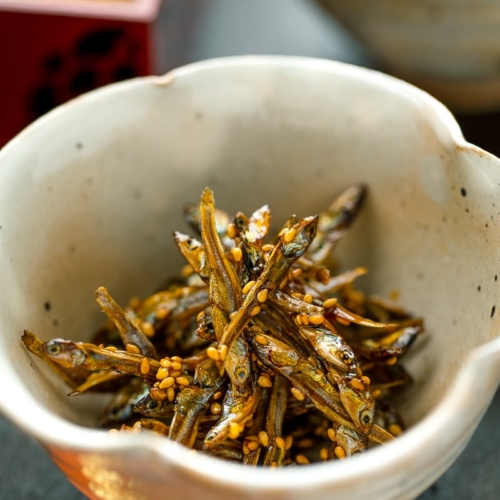
Tazukuri (Candied Anchovies)
Video
Ingredients
- 1 cup tazukuri (dried anchovies) (tazukuri is only available in December at Japanese markets; you could use iriko or niboshi (boiled and dried anchovies), but they will be slightly saltier since they are boiled in salt water before drying)
- 1 Tbsp toasted white sesame seeds
- 2 Tbsp sake
- 1 Tbsp sugar
- 1 Tbsp soy sauce
- 1 Tbsp honey
- ⅛ tsp neutral oil (optional, but it helps to separate the anchovies once cooled)
- 1 red chili pepper (optional; leave whole and add it to the simmering sauce for a spicy kick)
Instructions
- Before You Start: If you will include this dish in your Osechi meal, I recommend cooking it up to 4 days before you plan to serve. For more helpful tips on planning your Japanese New Year feast, please read my A 5-Day Osechi Cooking Timeline blog post.
- Gather all the ingredients. Prepare a baking sheet lined with parchment paper.

- In a dry frying pan (no oil), toast 1 cup tazukuri (dried anchovies) on medium-low heat for 5–10 minutes or until crispy.

- Next, add 1 Tbsp toasted white sesame seeds to the frying pan and toast for 2 minutes. Shake the pan constantly so the sesame seeds don’t burn. When you can break an anchovy into two pieces with your fingers, transfer the anchovies and sesame seeds to the lined baking sheet.

- To the same frying pan, add 2 Tbsp sake, 1 Tbsp soy sauce, and 1 Tbsp sugar. Give a quick stir.

- Next, add 1 Tbsp honey and ⅛ tsp neutral oil. Add the optional 1 red chili pepper to the pan now, if using.

- Bring it to a simmer on medium-low heat. Then, reduce the sauce until it thickens and you can draw a line through the sauce on the pan‘s surface with a silicone spatula.

- Add the anchovies and sesame seeds back to the pan and coat well with the sauce. Once the anchovies are nicely coated with the sauce, transfer them back to the lined baking sheet. Spread the anchovies to let cool.

To Serve
- Once cooled, serve at room temperature to enjoy.

To Store
- You can keep the leftovers in an airtight container and store in the refrigerator for 7–10 days.
Nutrition
Editor’s Note: The post was originally published on December 21, 2013. It’s been republished in December 2021.
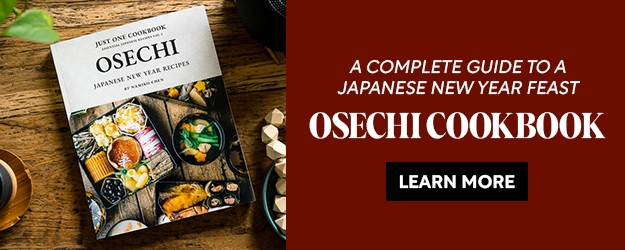
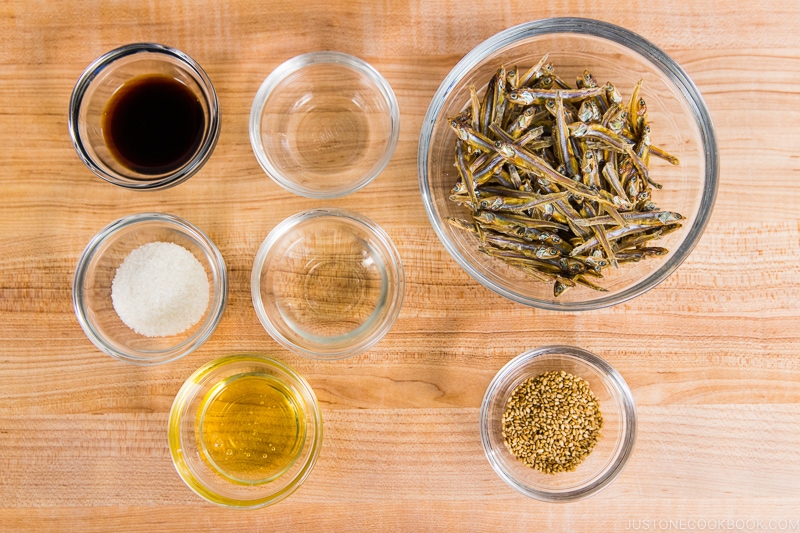
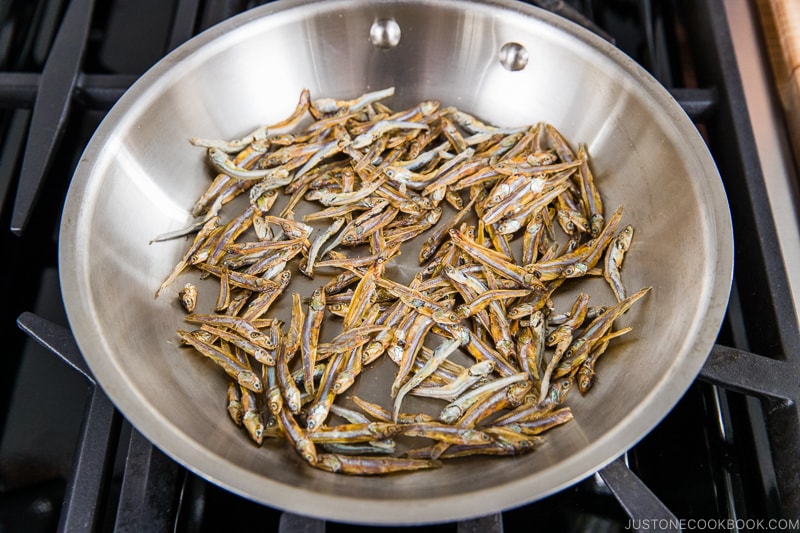
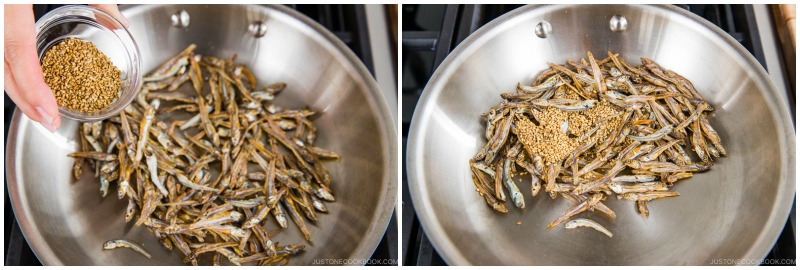
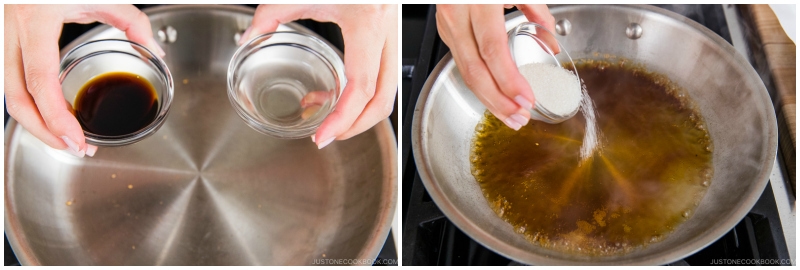
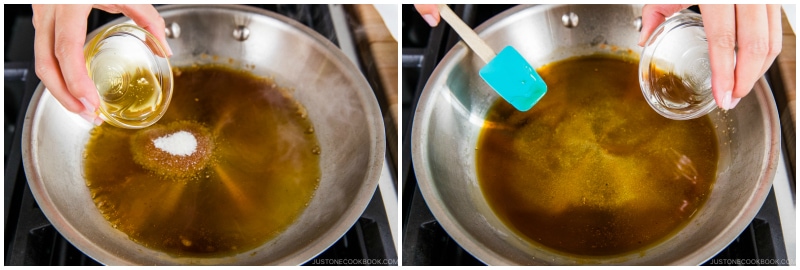
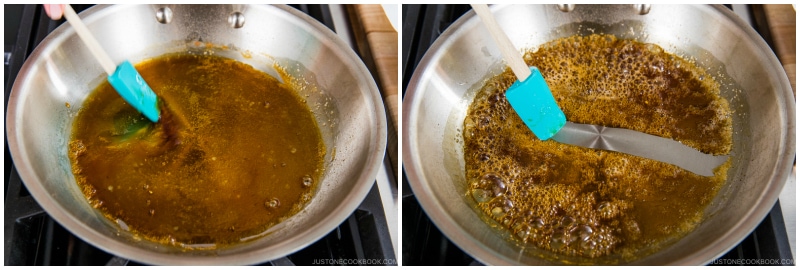
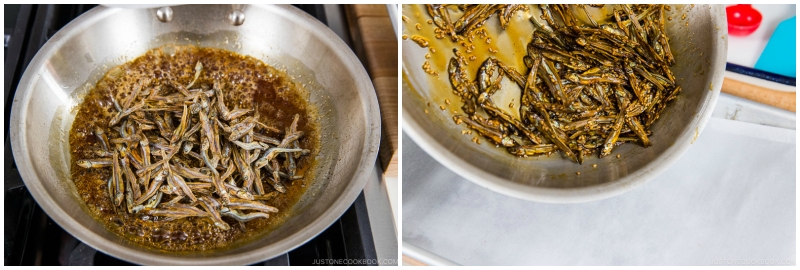
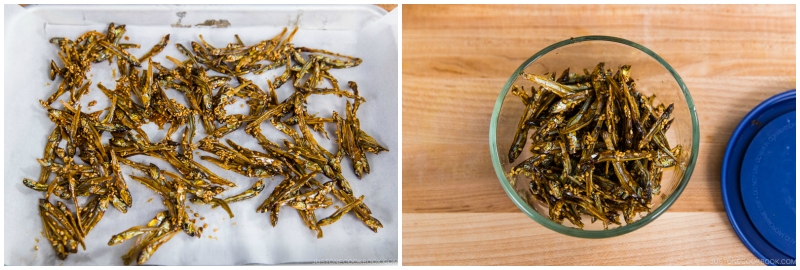











Deliciously addictive! A bit salty (used Chinese light/regular soy sauce) on their own but after adding some slivered almonds as Nami suggested it became a yummy snack for the whole family. Will try with a bit less soy sauce next time. They won’t last long, luckily they are easy to make 😃.
Hi Karen! Thank you very much for trying Nami’s recipe and sharing your cooking experience with us!
We are glad to hear you enjoyed the Tazukuri with almonds!☺️
Hello !
I tried this recipe today, twice actually,
Respected the proportion exactly, but it was awfully salted… I can’t get what I got wrong … :/ The dried anchovies I have contain 1% of salt, is that normal …?
I have no clue if I did something wrong of if it’s supposed to be really sugary and -that- salted… I even use soy sauce with -25% less salt !
Do you have any idea what could have possibly go wrong ? :/
Or could you tell me if it’s meant to be really salty.
Thanks a lot !
Hi Tamara, Thank you very much for trying this recipe. We are sorry to hear this recipe did not work well for you.
Tazukuri is one of the popular dishes for Osechi and made it to keep each meal interesting and appetizing over three days. Hence, Osechi Ryori includes various dishes that are made to keep for several days and often salty or very sweet.
Please use a scale to measure the dried anchovies. If it still too salty, please feel free to adjust the taste by mixing the walnut or almond (unsalted) to tone down the saltiness. We hope this helps.
I made this recipe for my wife and her family for New Year’s. They’re from Czech Republic, so they’re used to the meat and potatoes kind of meals and they refused to try any, BUT I absolutely love them! I’ve been snacking on them constantly and was thinking of adding them on top of ramen or devilled eggs for a nice sweet and savory crunch! Next year I’d definitely like to tackle more of the Osechi Ryori!
Hi Tessa,
Thank you very much for trying this recipe and introducing Tazukuri to your family!
Hi Nami,
I just tried out this recipe, using niboshi (it’s actually the same packet and brand as the one in your ingredient page), and they turned out very hard. The anchovies were crispy and I was able to snap them in two pretty easily after dry frying them, but maybe I didn’t cook them for long enough? I still have half a packet left and 3 days until New Year’s – let me know what you think might have gone wrong!
Hi Lia,
Thank you very much for trying this recipe!
Step 2, the anchovies should be crispy, and as soon as you coat them with the sauce, it will be a little softer.
Please make sure not to cook the fish at Step 7 as it get caramelize and turn to candy. It would be best if you coated them with the sauce quickly.
We hope this is helpful!
Thank you! I think that was definitely the problem – I kept stirring the anchovies in the sauce with the heat on, trying to get them coated evenly, which made the sauce caramelize and harden a bit. Luckily my family doesn’t seem to mind too much, so I’ll add it to our osechi ryori and try to get it right again next year 🙂 良いお年を!
Hi Lia,
It is our pleasure!
We are glad to hear it worked out for your Osechi!
Have a wonderful New Year! 良いお年を!🎍
Sorry Nami…I see the step where you add the oil (with the honey). Please disregard my question earlier. Thank you for your wonderful recipes. My favorite site for Japanese recipes!!!
Hi Kaila!
We are glad to hear you found the answer in the recipe!😉
Thank you for trying this recipe and for your kind feedback!
Dear Nami,
At what point do you add the oil to prevent it from sticking to each other. I will make this recipe for New Years.
Thank you very much for the thorough explanation on how to make this delicious snack! Now for people with delicate teeth, I’d like to share my experience: I’ve noticed that the fish eyes are really hard, just like small spherical rocks. Think biting medium to large sized grains of sand! After a couple of very painful episodes, I am now thoroughly extracting and discarding all the eyes in a first step. Some might note that important nutrients are located just around the eyes… but I’d rather prefer not to damage my teeth -once eroded, enamel won’t regenerate.
Hi J.M.! Thank you so much for your detailed feedback and tips for others! I’m glad to hear you enjoyed this recipe. Thank you!!
[…] sticky and coated the snacks with them to make my own candied dilis. In Japan they’re called Tazukuri.) This is really less of a recipe and more of a method of cooking. (Edited to add: I’ve made my […]
[…] Tazukuri (Candied Sardines) […]
[…] 5. Tazukuri (Candied Sardines) 田作り […]
Hi, may i know how should I prepare Tazukuri with the baby anchovies leftover from Iriko dashi? Hope to hear from you please!
Hi Fiona! I don’t think it tastes good with leftover anchovies which flavors are taken out to make daashi. So I personally don’t recommend.
Hi Nami, thank you for getting back to me!
Oh dear, I’m guessing I may have mistaken this point ‘You can make Tazukuri (Candied Sardine) with leftover iriko. If you don’t make it right away, you can freeze the iriko and defrost to make it later on.’.
I believe you meant the remaining dried iriko in the packet & not the reserved iriko from making dashi right? Hahaha.
Hi Fiona! I should have explained better earlier. IF you already have the leftover sardines/anchovies from making dashi, and do not want to throw away, YES you can season it just like Tazukuri recipe and eat it. But it’s more of enjoying the texture and seasonings.
What I meant earlier in the comment was that this traditional recipe is not supposed to be made with leftovers from making dashi. In the iriko dashi recipe where I mentioned “you can make Tazukuri with leftover iriko”, I should have said you can “season the leftovers” just like Tazukuri recipe, NOT “make Tazukuri”… Maybe less confusion. 🙂
One of the first ‘local’ specialities that I immediately developed a love for — and today here in Japan my grocery store is filled with Tazukuri and I’m nibbling away. But it’s not New Years! No matter … num num num.
Haha! This was often in my lunch box too for extra calcium intake… 🙂 The quality of fish is good here. Definitely good snack! 🙂
Do you need to rinse the sardines?
Hi Gertrude! I don’t – usually only clean ones are in the package. But if you see yours are not good condition, maybe it’s okay to rinse quickly. Not soaking. 🙂
Thank you. Nami. Will definite make this.
I love this recipe. Thank you!
Thank you Patty! So happy to hear that! 🙂
Dear Nami
Could you use normal sardines for this recipe or does it have to be dried “baby” sardines?
Hi Naseera! We only use dried sardies that are small for this recipe. They have to be dried or else I think the texture of outcome will not be crunchy. 🙂 The size may not be that much of an issue, but must be dried. 🙂